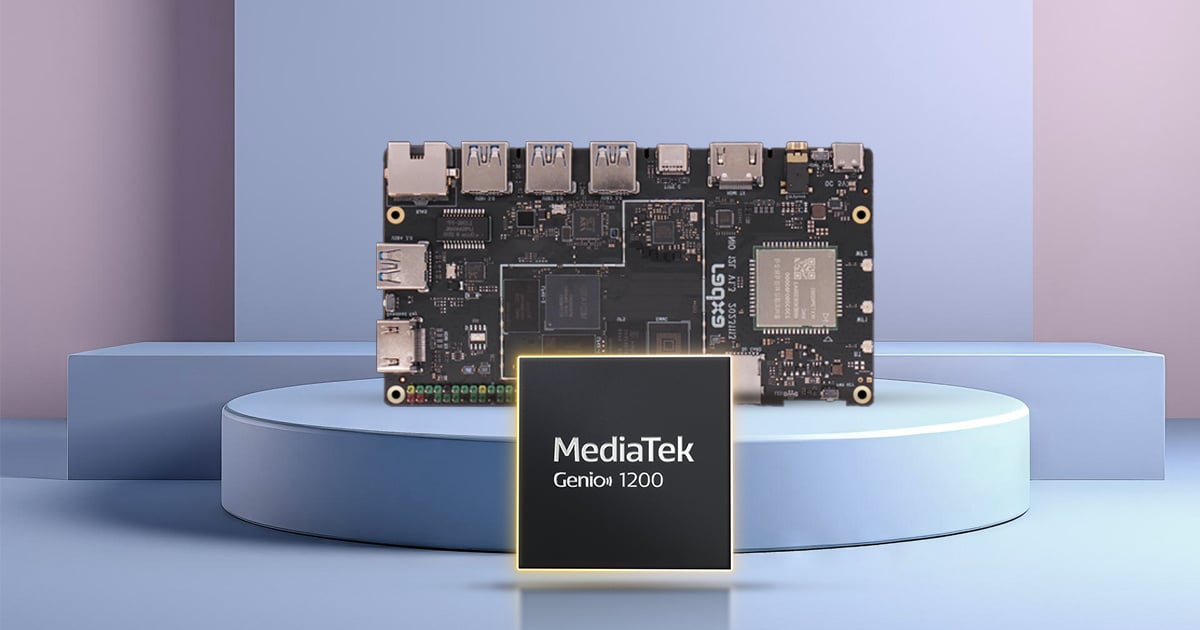By Alfred Chan, Vice President of Technical Product Marketing for TV Business Unit and Intelligent Multimedia Business Unit at MediaTek.
When composer Hildur Guðnadóttir scores acclaimed works like “The Joker” and “Women Talking,” her evocative music creates an immersive sonic journey. Individual elements move around audiences, transporting them deeper into the story. Emotions soar. Characters come alive.“I've always been fascinated with sound spatialization,” Guðnadóttir says. “I think your psychological perception of sound is really different when it comes from different places. I've been exploring that for many years – your perception of music when the sound is moving.”
This immersive experience, previously confined to movie theaters, is now making its way into homes through the latest advancements in TV audio technology. Launched last fall, Dolby Atmos FlexConnect – enabled by chipsets from MediaTek, one of the world’s largest fabless semiconductor companies – creates wireless, room-filling audio regardless of where you place your speakers.
Guðnadóttir’s dynamic soundscapes come alive, tailored to your home’s multi-speaker environment. FlexConnect fuses together the audio experience between your television and the other speakers throughout the room – steering the sound, literally, around your space.
“[Before], one sound was meant for the left speaker, another for the right. Now it’s, ‘We want this sound to start here and go there,’ and the technology steers it.” – Vikram Shrivastava, Director of Marketing at MediaTek
How TV Design Spurred Audio Innovation
Anyone born in the 20th century remembers the era of televisions requiring cathode-ray tubes –electromagnetically steered beams, fired inside a vacuum tube, that appeared on the other side of a phosphorescent screen as your characters, from Lucy Ricardo to Steve Urkel. That meant TVs were deep and heavy, with comparatively small screens.
At the same time, this left enough space for relatively high-quality speakers. You could install a full range of drivers, with proper diaphragms and enclosures to produce rich sound with minimal distortion. And TV speakers could face the same direction as the screen, leaving viewers awash in sound waves.
Flat-screen TVs upended this. With the screen taking virtually all the front real estate, speakers were down-firing or back-firing. And as flat-screens got progressively thinner, the space for high-quality audio hardware diminished. Sound became tinnier; bass went belly-up. Television makers began investing less in audio componentry.
Demand for audio quality didn’t diminish, of course. It just moved away from the television itself.
Home theater with surround sound existed in the days of CRT televisions, with speakers placed strategically around the listener – each one playing a separate channel at ear level, subwoofer (bass) level, or even height (overhead) level. But flat-screen TVs gave an even better reason to adopt this approach. Audio innovation had shifted to outside components like the soundbar or satellite speaker systems.
The Culmination: Object-Based Audio
In the late 2010s, surround-sound audio sparked a new trend: object-based audio, with MediaTek chipsets and brands like Dolby Atmos leading the way. Object-based audio was exactly what it sounded like – instead of distributing sounds with limited channels directed at you from the TV, they’re interpreted as audio objects that can be arranged just so in a room. The effect is that of realistic and immersive sounds projected around our ears in lifelike spatiality.
Visit a Dolby Atmos movie theater, with hundreds or more speakers perched around the auditorium, and you’ll notice how sounds move across a three-dimensional soundscape. Rain falls on forest leaves to your front left, and then pitter-patter over to the foliage behind your right shoulder.
The 2013 film “Gravity,” an earth-orbit thriller starring Sandra Bullock and George Clooney, was the first movie mastered in Atmos.
“The whole scene where the space station is spinning – that was one of the most amazing experiences in cinema at that time, and it kind of broke all the rules,” says Vikram Shrivastava, MediaTek’s Director of Marketing. “They could make a spaceship hover right over your head using a mix of speakers, which they couldn’t do before – one sound was meant for the left speaker, another for the right. Now it’s, ‘We want this sound to start here and go there,’ and the technology steers it.”
An Atmos-enabled multichannel home theater could bring a similar experience home, but consumers balked at the trade-offs.
New Soundscapes, Powered by Listeners
The average consumer seldom has the space or aesthetic desire to accommodate an optimal surround-sound setup. A piece of furniture might be right where you should place a speaker. Or maybe you prefer the wireless, clean-wall aesthetic that suits a flatscreen and don’t want to ruin it with a big A/V receiver.
Plug-and-play soundbars offer a cleaner look, but they typically need to be wired to the television with HDMI cable using eARC (Enhanced Audio Return Channel) – so they tend to project sound straight off, say, the shelf a TV sits above. That’s not necessarily ideal for audio, depending on where you sit. For instance, when the TV is in one corner of a room facing an L-shaped sectional, the TV-attached soundbar projects audio to the space between the sofa sections.
However, with the Dolby Atmos FlexConnect system, users take their own FlexConnect-enabled speakers and connect them to a FlexConnect-enabled television. The speakers calibrate themselves – letting the TV know their locations. The TV chips capture and map the locations and then steer the audio objects correctly to each wireless speaker – left, right, and rear. It all happens seamlessly.
The speakers even signal their capabilities. A three-way speaker, for example, tells the television that it has a lot of bass. The sound is distributed accordingly. Advance configuration speakers can have up-firing capability for ceiling-emanating audio.
It’s technology-aided sound – something Hildur Guðnadóttir knows a thing or two about.
“The more you start to play with electronics and technology, the further you can get.” – Hildur Guðnadóttir
New Music, Powered by Technology
“Technology has been a huge part of my process,” says Guðnadóttir, a classically trained cellist. “I’m really interested in exploring the possibilities that technological advancements give us in a way that combines the old and the new – traditional instruments building off each other to create sounds I never knew could exist.”
That’s always been part of her past, from exploring pedals, microphones, and recording techniques back when she was in a band to pushing the envelope with her acclaimed scores. Indeed, Guðnadóttir’s music has a flair for the unique, whether it’s a few stringed instruments playing off each other or, in the case of her Grammy award-winning score to “Chernobyl,” the unsettling sounds of a nuclear power plant.
“The more you start to play with electronics and technology,” she says, “the further you can get.”
Data Transmission, the Unsung Hero
Whether you’re feasting your ears on a Dolby Atmos-enhanced viewing of “Gravity” or “Chernobyl,” the unsung hero of object-based audio is data transmission. It requires more data than you think – certainly more than ordinary Bluetooth wireless technology can support, leaving Wi-Fi as the only solution.
But earlier standards like Wi-Fi 4 and Wi-Fi 5 lacked the capacity to support multichannel audio. Wi-Fi 6 allowed for more channels (as many as a dozen), and now Wi-Fi 7 – with MediaTek having some of the first chipsets enabled for it – has the throughput and range to give true object-based audio over wireless speakers.
The technology comes by way of a fortunate coincidence: Speakers and output technology matured at around the same time as online bandwidth got robust enough to handle the wireless steering of multichannel sound.
Space in Music – and Music in Space
If you’re trying to move music through space, Guðnadóttir’s scores are a great place to start. In “Tar,” her stripped-down strings bend sound frequencies up and down, joined occasionally by deliberate, sparse percussion. “Chernobyl” blends the bone-chilling sounds of electricity transmission with haunting choral strains, turning the power plant itself into an instrument.
“I try to write music that’s part of the storyline but still leaves a bit of space for interpretation,” Guðnadóttir says. “I think it’s interesting as an audience if you have some questions and space for yourself.”
If anything was made for object-based audio, it’s scores (and movies) like these. And soon, MediaTek hopes to bring this technology to the masses.
We foresee some of the audio processing happening in the speaker itself, rather than the television, to reduce the burden on legacy TVs. Our engineers hope to soon scale up audio quality through the speakers’ chipsets, even if your TV is old or inexpensive by comparison. This could eventually open Dolby Atmos FlexConnect to entry-level TVs – in effect democratizing the technology among a wider range of consumers and price points.
Guðnadóttir is all for expanding accessibility.
“As I learn more about the possibilities opening up through technological advancements from companies like MediaTek, it opens up a whole different dimension to the home audio experience that’s normally reserved for a concert or cinema environment,” she says. “It’s exciting to make immersive audio more accessible to general audiences.”
To learn more about how MediaTek's technology drives immersive experiences, check out our Visionaries on Vision series with Hildur Guðnadóttir.









